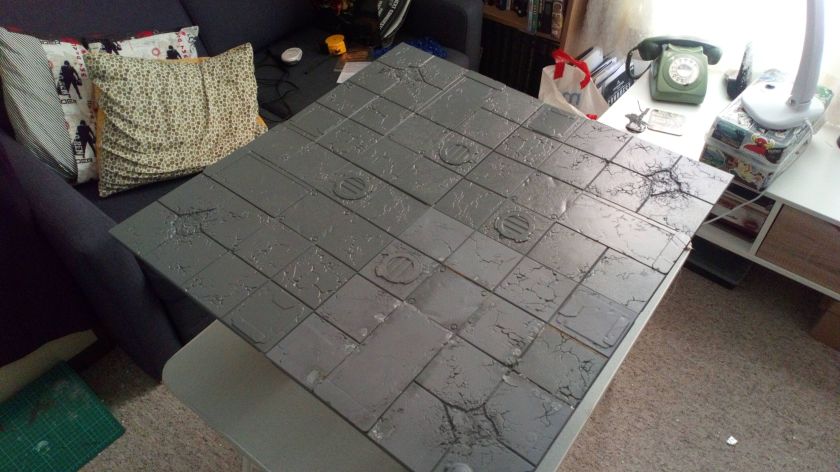I’ve managed to get a bit more work on the 28mm scale scratch built Oil Rig. Having finished off the bulk of the superstructure I’ve now moved on to looking at the main body of the rig.
As previously discussed I have approached this in a module manner. Each of the 2 foot square tiles now has a removable leg support and ‘concrete boot’, the idea being that the four of them can be arranged in any combination to vary the gaming service as required. Each of these component parts of the platform will be themed to a specific ‘function’ of the oil rig and in summary these will be bridge/ops centre/crew quarters, helicopter landing pad, loading crane/storage area and refinery.
It’s the latter two that I have been initially concentrating on.
Refinery
For the refinery I have used a modular plastic model kit of a ‘Chemical Plant’. Manufactured by Tehnolog in Russia, but sold under licence around the world (in the US by Pegasus Hobbies and the UK by Pocketbond) this kit is out of production but you can still find the odd boxed and version on eBay.

I picked up a complete set a few months ago with the original intention of this being used for a post apocalypse tabletop for 7TV. In the end this fits the bill for ‘the business end’ of the oil rig quite nicely. Fully hard plastic and stuffed full of components, this is really like a lego kit for wargames scenery builders. It does have some instructions and suggestions on how to build, but I really just free formed it with all the pipes, valves and tanks available. This did end up being a bit fiddly, but was a gentle distraction for a couple of hours. In addition to the core bits and pieces from the kit I added in some extra touches from my bits box, including some 40k scenery bits (in red plastic in the photos) and some platform pieces from the Robogear Starter Set (also produced by Tehnolog).
Rather than build this directly onto the platform I found a separate base for this (an old Warhammer movement tray), with addition of some magnets I’ll be able to use this as part of the rig table or just as a standalone piece elsewhere (meaning it may see the apocalypse after all).

For the time being I have kept painting simple, a black undercoat and all over gun metal drybrush. Various ‘tanks’ have been picked out in red, with ‘valves’ painted gold. At some point moving forward I will look to weather this up suitably.
Crane and loading area
For this part of the board I wanted a big structure and rather than try and build something completely from scratch I’ve gone down the MDF kit route. TTCombat do some really good value kits and I’ve gone with their ‘dockside crane’. Again I’m approaching this from a modular view point with the idea being this can be removed from the rig and used as a separate piece on a different board as required.
The build on this was fairly straightforward, with minimal fuss, although the tolerances were very tight and I have had to do some creative trimming to make all the parts fit. This was more down to my lack of care and precision rather than any inherent issue with the kit.
I painted this in quite a basic manner blocking out colours roughly and allowing the subsequent weathering to do a lot of the work for me (masking mistakes and dulling down some of the primary colours). Warning stripes were added using an MDF stencil, again from TTCombat. The stenciled lettering and logos on were ‘painted’ using Gundam paint marker pens.
I wanted to give the crane a look that, although operational, it was no longer cared for or maintained properly. This involved extensive use of rust effects, including dry brushing of Citadel Ryza Rust, a liberal application of some Modelmates Rust Effects and the use of weathering sprays from Plastic Soldier Company. The whole model was then sealed using a liberal all over spray of Testors Dullcote.
Platform tiles
I’ve also started to add some colour to the platform tiles themselves. Again I am keeping this quite basic for the time being. A base coat of silver was applied using a cheap (and very smelly) can of paint sourced from Poundland and an brush on of Army Painter Quickshade Dark Tone was then applied. This was again dulled and sealed using Dullcote. There is some further tidy up and weathering to do here, but that is for another time.

It’s all starting to come together and although time is rapidly running out, I’m still on track to debut this at the 7TV campaign day at Dales Wargames on May 26th.


























































